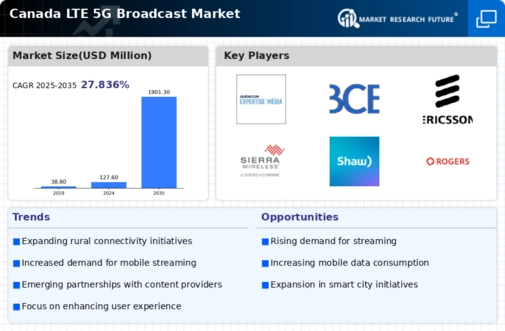Rising Consumer Expectations
Rising consumer expectations in Canada are driving the lte 5g-broadcast market. As users increasingly demand high-quality streaming services, the need for efficient broadcasting solutions becomes paramount. The proliferation of smart devices and the growing popularity of mobile video consumption have led to a surge in demand for high-definition content. According to recent surveys, over 70% of Canadian consumers express a preference for uninterrupted streaming experiences. This trend compels service providers to enhance their broadcasting capabilities, thereby propelling the lte 5g-broadcast market forward. Additionally, the expectation for low latency and high reliability in mobile broadcasting further emphasizes the necessity for advanced technologies. As consumers continue to seek superior content delivery, the lte 5g-broadcast market must adapt to meet these evolving demands, ensuring that service providers can deliver the quality and reliability that users expect.
Expansion of 5G Infrastructure
The expansion of 5G infrastructure in Canada is a pivotal driver for the lte 5g-broadcast market. As telecom operators invest heavily in upgrading their networks, the availability of high-speed connectivity is expected to increase significantly. Reports indicate that by 2026, approximately 80% of the Canadian population will have access to 5G services. This widespread adoption facilitates enhanced mobile broadcasting capabilities, allowing for higher data rates and improved user experiences. The lte 5g-broadcast market stands to benefit from this infrastructure growth, as it enables seamless delivery of high-quality content to consumers. Furthermore, the deployment of 5G technology is likely to attract new players into the market, fostering competition and innovation. Consequently, the expansion of 5G infrastructure is not merely a technical upgrade; it represents a fundamental shift in how content is consumed and delivered across Canada.
Government Initiatives and Funding
Government initiatives and funding play a crucial role in shaping the lte 5g-broadcast market in Canada. The Canadian government has recognized the importance of digital infrastructure and has allocated substantial resources to support the deployment of 5G technology. Recent budgets indicate an investment of over $1 billion aimed at enhancing broadband access across rural and urban areas. Such initiatives not only facilitate the growth of the lte 5g-broadcast market but also aim to bridge the digital divide, ensuring equitable access to high-speed services. Furthermore, regulatory frameworks are being established to streamline the deployment process, which could potentially accelerate market growth. By fostering an environment conducive to innovation and investment, government support is likely to catalyze advancements in mobile broadcasting technologies, ultimately benefiting consumers and businesses alike.
Technological Advancements in Broadcasting
Technological advancements in broadcasting are significantly influencing the lte 5g-broadcast market. Innovations such as edge computing and enhanced encoding techniques are enabling more efficient data transmission and improved content delivery. These advancements allow for the optimization of bandwidth usage, which is essential in a landscape where data consumption continues to rise. The lte 5g-broadcast market is poised to leverage these technologies to provide superior broadcasting services. For instance, the integration of artificial intelligence in content delivery systems can enhance user experiences by personalizing content based on viewer preferences. As technology continues to evolve, the potential for new applications and services within the lte 5g-broadcast market expands, suggesting a dynamic future for broadcasting in Canada.
Increased Competition Among Service Providers
Increased competition among service providers is a driving force in the lte 5g-broadcast market. As more companies enter the market, the competitive landscape is becoming increasingly dynamic. This competition encourages innovation and the development of new services, which can enhance the overall quality of broadcasting. Recent market analyses indicate that the number of service providers in Canada has grown by over 30% in the past two years, leading to more choices for consumers. This influx of competition is likely to result in better pricing strategies and improved service offerings, as companies strive to differentiate themselves. The lte 5g-broadcast market must adapt to this competitive environment, focusing on delivering value-added services that meet the diverse needs of consumers. As competition intensifies, the potential for growth and innovation within the market appears promising.

















Leave a Comment